Ventilation of the foundation of the house: rules and options for organizing air exchange
The duration of the operation of the building is directly related to the beginning of its construction. Properly mounted ventilation in the foundation of the house will prevent the destruction of floor materials, walls. From this stage of work depends on the durability of residential, non-residential premises and the health of people in them.
You will learn all about the rules and regulations for constructing a ventilation system to protect the foundation of a house from the article we presented. We will talk about the reasons according to which the removal of moisture from the foundation is satisfied. We’ll introduce you to proven methods, a calculation scheme, and installation steps.
The content of the article:
Variants of ventilation systems and schemes
The regulation of the construction of the ventilation system by domestic SNiPami (Building Norms and Rules) and international building standards.
Reasons for regular airing
Some consequences of the absence or improper ventilation system in the foundation:
- The appearance of condensate, a gradual increase to 100% humidity;
- Rotting of wooden beams, floors, rough materials of floor construction;
- The accumulation of natural gas of radon released from the soil, the inhalation of which leads to oncology;
- Reproduction of mold, fungi, other microorganisms that cause allergic diseases, bronchial asthma.
To comply with the humidity regime, evaporation of accumulating moisture and its removal from under the floor of the house to the street is required.Neglecting construction standards, you can cause irreparable harm to the health of tenants at home.
Organization of natural ventilation
The choice of ventilation option is determined by economic feasibility.
There are two main ways of arranging natural ventilation:
First method. Installation of special holes in the foundation, called vents or vents.
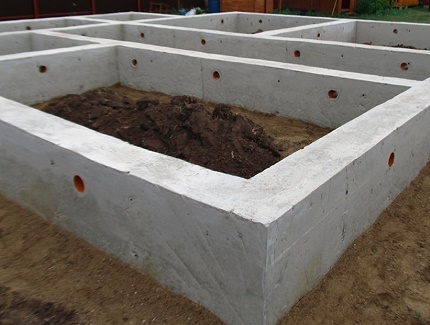
Second method. Supply and exhaust ducts. They take away moisture, harmful gases from the basement and take it to the street through exhaust ventilation risers.
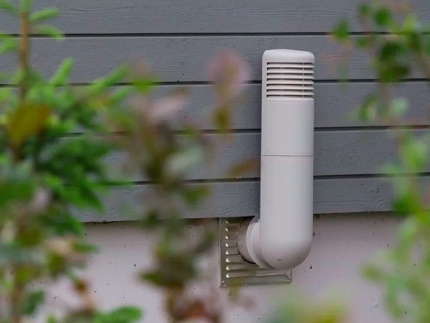
The first method is cheaper in construction, but will require additional costs for heating the house during operation. The second method is effective only with an integrated approach to energy conservation.
It requires high costs for the insulation of the foundation, the creation of a waterproofing barrier, construction blind areasducts or pipes. Investments will not pay off without conducting insulation work and high-quality insulation of the entire house from the inside.
Forced system device
Natural ventilation depends on the temperature and density of the air mass in the street and indoors. It does not work when the air temperature in the street and in the basement are equal. With high humidity and low efficiency of the natural air exchange system, it is supplemented by electric devices, fans.
Forced ventilation is usually applied:
- in basements from 40 m2 or with insulated compartments;
- in architectural solutions of a house without ventilation ducts and pipes over the roof;
- in rooms equipped with sources of odors and humidity in the basement - workshop, garage, sauna.
Instrument Power supply and exhaust ventilation calculated on the basis of the volume of the basement.
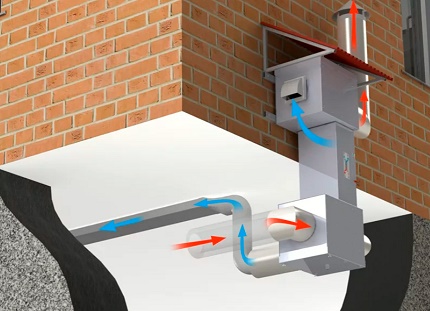
In mechanical ventilation systems, either a supply fan or an exhaust fan is activated. If the mechanism works on the inflow, then the air pumped by it spontaneously displaces the exhaust air mass from the basement. If the hood operates, then the air is drawn into the space naturally thanks to it, naturally.
When is it possible without ventilation?
The need for the installation of air ducts or ducts disappears in any foundation without a subfloor. No basement - no problem.
But not always, but only when at least one of the following two conditions is fulfilled:
- A concrete slab is installed on the grillage of the columnar foundation, and the space inside is completely filled from soil to the floor with a well-filtering material - sand, expanded clay, granular foam glass. Excess moisture in them simply and quickly evaporates.
- Stacked drainage system water drainage from the foundation. Excess water is collected by drains - perforated drainage pipes, and discharged into the sewer well or sewage pit outside the site.
- A durable waterproofing has been installed that wraps all the base elements with a water-tight layer of gluing or surfacing material, as well as a complex of materials.
You can refuse ventilation vents when using the floor or basement as a storage. You just need an open passage to the living area of the house and ventilation windows with bars or opening transoms.
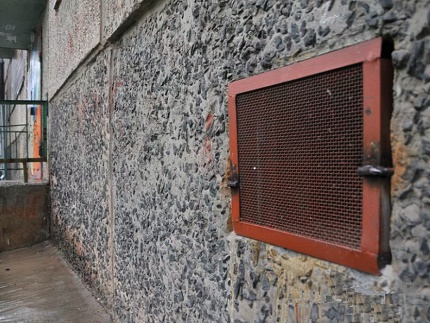
The homeowner decides for himself whether special vents or ducts are needed in the foundation of the open-floor house. Refusal of products in the above cases allow standards IRS-2006R408.3. In other constructions of the foundation, a ventilation system is required.
Specific ventilation ventilation
The openings in the foundation for fresh air circulation simply and cheaply provide ventilation. Outlets drain condensate well, creating dryness in the basement.
Parameter calculation steps
For effective ventilation, the number of openings and dimensions are carefully determined. Regulates the location, size, number of vents SNiP 31-01-2003.
During construction, the following requirements must be observed:
- The diameter of the round section must be at least 25 cm.
- The minimum area of one hole without reinforcement is 0.05-0.85 m2;
- The total cross-sectional area of all vents should be more than 1/400 of the base of the house;
- With an increased content of radon in the soil, the total area of openings is increased to 1/100 of the basement area.
Most owners of private houses prefer the installation of ventilation openings with a minimum permissible diameter, increasing the number of vents if necessary.
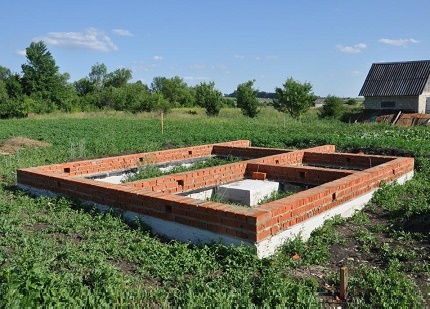
Naturally, if the laying of the foundation or basement level is carried out with brick or foam concrete blocks, then the square configuration of ventilation outlets is a priority.
But when pouring the foundation concrete "tape" preference is given to a circular cross section. It is obtained when drilling structures for the ventilation device after construction.
Arrangement options for perfumes
The device of exhaust and supply openings has the following features:
- The first vents from each corner are recommended to be made no further than 0.9 m;
- The distance between the holes is set no more than 3 m;
- The distance from the ground level is from 3/4 to 2/3 of the height of the foundation;
- From the opening to the bottom of the base plane should be at least 30 cm;
- Have vents symmetrically on opposite sides;
- With a low foundation, you will have to dig pits under the vents.
Openings are also made in the partitions of the cellars.
Hole mounting process
Sinuses are laid during pouring concrete of the “tape” of the foundation. Usually used for installation plastic pipes. It is necessary to fill them with sand, which prevents deformation and breakage, which is removed after the concrete is dried.
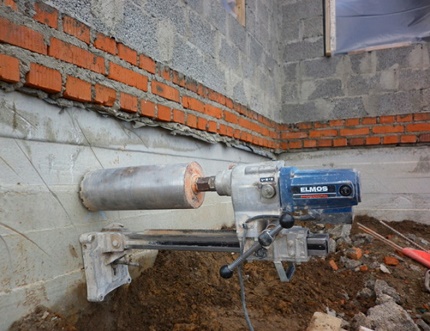
Step-by-step instructions for performing work:
- Draw a future foundation by placing on the paper the calculated number of vents with dimensions;
- Prepare cut pieces of pipes with sand with a length equal to the width of the foundation "tape", tightly ram the ends with rags;
- Place pieces of pipes, sleeves in the formwork for pouring concrete, fastening each end of the future outlet tightly to the walls of the formwork;
- Pour concrete formwork with pipes, after hardening, clean the pipes and install protective grids.
Do not limit the openings with wooden blocks when pouring the foundation. Their dismantling will require additional efforts, loss of time, damage concrete walls.
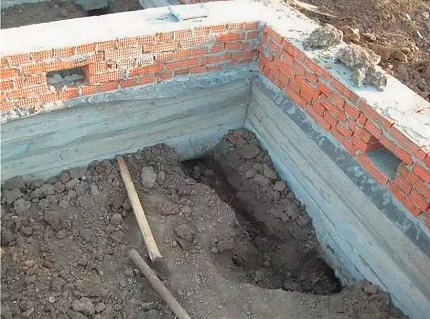
Square holes in masonry are obtained by stacking elements and using cut brick.
Aperture protection methods
It is necessary to close all through products with special plugs or gate valves that allow air to pass through. They protect the base from the penetration of birds, cats, rats, mice and other small animals.
Various types are used based on personal preferences:
- Plastic products have a modern aesthetic design, diverse shapes, including in the form of bends at right angles. They are often installed on small openings.
- Strong reliable fastenings provide durability to metal shutters. Lattices from fittings, nets from stainless steel, welded to the corners, are usually used on wide openings.
- For individual orders, beautiful and strong lattices can be made in workshops. They will become not only protective elements, but also decorative decorations of the facade.
Polymer blinds and grilles are mainly used in arranging small ventilation openings.
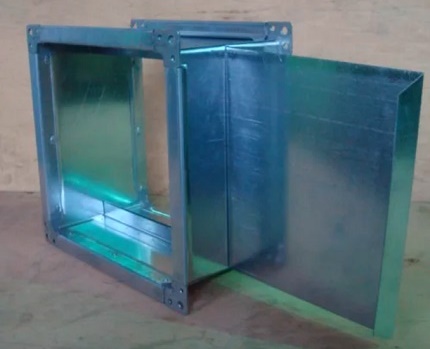
If the ventilation hole in the foundation or base is blocked by a stationary grille, it is possible to partially / fully open / close the opening with the help of a gate mounted in the air duct.
Air ducts for hoods
This form of supply and exhaust ventilation is suitable for all types of foundations. The floor on a monolithic, columnar, pile foundation will be the most dry and warm with it.
Preparing for the construction of the system
For the installation of exhaust ducts usually use pipes or boxes. They can be plastic, metal, brick, wooden. Each type of material has its pros and cons.
The choice of material for assembly
The main differences between the designs:
- Metal ones have a long service life, they are slowly polluted, but they are expensive and difficult to install;
- Easy to assemble pipes from PVC, due to the presence of a variety of fasteners, affordable;
- Wooden boxes are the most inexpensive option, they are environmentally friendly, but less durable.
Each owner decides what material to choose and how to make reliable ventilation in the foundation, based on their financial capabilities. In large cottages, exhaust pipes are often made of bricks. They are connected to a common duct system and provide good ventilation throughout the house.
Sizing Rules
The precise parameters of the ventilation system guarantee the required air circulation.
- The length of the exhaust pipes is equal to the height of the house plus 1.5 m;
- The duct section must be at least 26 cm2 per meter of basement area;
- The total cross-sectional area of the exhaust pipes should be 15% larger than that of the supply pipes.
After all measurements and calculations, you can begin preparations for installation. Check the serviceability of tools, fixtures, stock up on material.
Channel installation steps
Before starting all work, a layout diagram of the elements of the ventilation system should be drawn up.
Air ducts are installed in the following sequence:
- The supply duct is mounted through an opening in the base or in another place, its lower end is located at a distance of 0.5 m from the floor.
- The pipe joints in the foundation openings are hermetically sealed;
- Exhaust structures are mounted under the ceiling, connected to a common channel with the outside of the pipe;
Adjustable dampers on the exhaust and supply air ducts will help prevent freezing of the basement in winter.
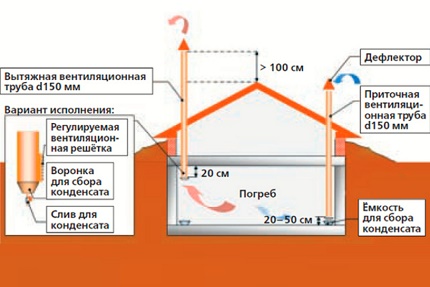
The height of the ventilation risers, towering above the roof, is usually taken equal to the height of the chimneys. In order to ensure stable draft in the hood, the top of the pipe should be 0.5 - 1.0 m above the ridge.
Determination of a place for construction
A house built in a well-ventilated area may have a ventilation system with a minimum number of outlets. It is enough to make only two openings in the foundation. In a building located in a lowland, the number of vents is increased to the maximum.
The location of the holes should be planned taking into account the wind rose. For example, if the calculations showed the need for equipment of 6 vents, then 2 of them must be located on the leeward side, 2 - on the opposite windward side and 1 on the remaining sides of the foundation.
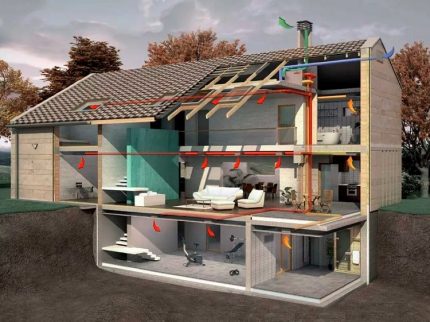
Supply and exhaust ventilation, which provides fresh air for operating premises located in the basement, is usually connected to a common ventilation network. So one recuperator able to handle the entire building. In addition, exhaust ventilation risers can be located in one shaft.
Weighted Question Assessment
Natural air exchange using vents in the foundation can be made from improvised materials, construction waste. All other options will cost.
Affect the cost of ventilation:
- The area of the basement and the height of the entire structure during the installation of ducts;
- Availability of equipment for forced ventilation. All simple fans and switches can be purchased for 3-5 thousand rubles;
- Additional devices. The cost of complex recuperators, split- systems, hygrometers, sensors with turnkey installation starts from 20 thousand rubles, often exceeds the amount of 100 thousand.
For the well-being of residents and the strength of the house, it is worth choosing an effective ventilation scheme for the foundation. It can be completely free or very expensive, the main thing is that the air in the basement is updated and the walls are dry.
The constructed ventilation system requires periodic measures to effectively maintain the microclimate in the basement.
Subtleties of competent operation
It should be remembered that the movement of dry air eliminates condensation. High-quality ventilation is possible with proper operation of the ventilation system.
It is necessary to constantly monitor the weather and carry out simple events:
- Close dampers during long rains and snow melt in spring.
- Regularly treat with lime or special antifungal impregnations the inner surface of the foundation;
- In the fight against excess moisture, you can use boxes with sawdust, sand, salt, periodically replacing the filler with dry.
The basement should be aired in dry summer heat, and in winter leave small gaps in closed sinuses for traction.
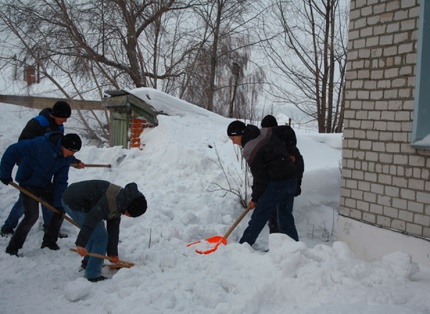
Even if the base of the house is protected by an efficient wall drainage system, regular snow cleaning is required. During the frosty period, during heavy rainfall, ventilation outlets should not be covered by snowdrifts.
Signs of poor ventilation
Not always ventilation provides a high level of safety of a comfortable microclimate inside the foundation. Sometimes in winter, cold air causes condensation to form when it comes in contact with a warm floor, which causes frost to form on the walls.
Causes of hazardous processes can be:
- Incorrectly calculated number of vents, foundation ducts;
- Close location of groundwater, marshland;
- The receipt of a large amount of moisture in the rainy season, melting snow.
Imbalance in the ratio between temperature and humidity indicates inadequate ventilation. To establish equilibrium, additional measures are required to drain the basement and adjust the ventilation system.
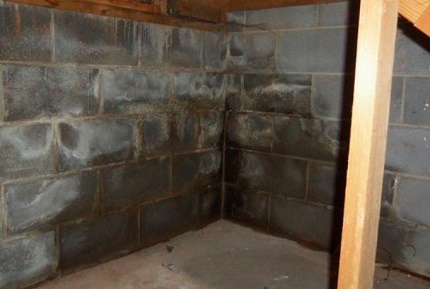
The foundation is not in vain called the foundation of the house. Its destruction due to the fungus will inevitably lead to the unsuitability of the building. Walls damaged by mold can still be saved by partially replacing building materials; these methods are not applicable to the foundation.
Ways to rectify the situation
If there is increased humidity under the floor, the fungus has begun to multiply, then this means that ventilation does not cope with its task. The problem has several solutions.
Option 1. Finalization and modernization of the design
It is necessary to inspect, make calculations and plan activities to optimize the existing system or install a new one.
To increase the ventilation of the basement, you can:
- Increase the diameter of existing vents, drill new ones. It is better to use the services of a construction company that has equipment for diamond drilling.
- Install additional air ducts from the basement to the roof of the house. Increased traction will provide effective moisture reduction.
- Run a forced ventilation device with an automatic timer. It is convenient to set up a differentiated thermometer that turns on the fan at a time when the temperature in the basement begins to exceed outdoor temperature.
Small amounts of condensation can be removed using a normal household fan. Or periodically connect a heat source, such as a heater.
Option # 2. Moisture penetration reduction
The reason for the increased humidity is usually a high level of groundwater. If ventilation is done as competently as possible, then you need to make or strengthen waterproofing protection. As a material, a polyethylene film with a thickness of 150 microns or more, roofing material or its newer versions — rolled surfaced materials — is suitable.
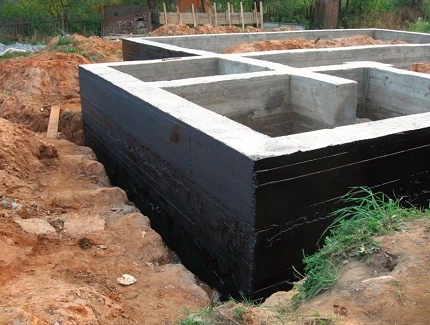
The process of laying polyethylene on the foundation of a small cottage or hozblok:
- Bring on the walls of the foundation at a distance of not less than 30 cm from the day surface, secure with slats;
- Lay the film in such a way that 15-20 cm one canvas comes on another;
- Gently glue the joints with double-sided tape on each side of the canvas;
Pour sand with a layer of at least 3 cm or make a small screed to protect the film.
A good effect will be obtained with a warmed base with blind area and the presence of a ventilation pipe. If there is no insulation, then condensate will collect on the film. In this case, it is possible to make a bias in one direction so that the accumulated moisture flows out of the foundation.
Option # 2. Exchange or purchase of new housing
In multi-storey buildings, residents of the first floors sometimes experience unpleasant situations associated with the operation of the ventilation system of the basement. Management companies should solve such problems. But sometimes they are in no hurry to do this, even in the presence of litigation.

Desperate people even try to exchange such apartments or live longer in the country. Sometimes they begin the construction of a private residential building on their own and step on the same rake. Therefore, it is very important at the initial stage of laying the foundation to think over and correctly implement the ventilation system.
When constructing a private house, the ventilation of the basement can be equipped either with your own hands or with the help of professional builders.
Conclusions and useful video on the topic
Visual demonstration of ventilation vents after the construction of a house:
The following video will introduce varieties of air ducts:
Features of the organization of supply and exhaust ventilation:
Whatever the system of ventilating the foundation — simple or complex, budgetary or expensive — it must function correctly. Therefore, home owners must constantly take care of the health of the equipment. It is necessary to try to improve the ventilation system of the foundation, when condensation appears in the basement.
Tell us about how you arranged the system in the foundation of your own country house / cottage. Please leave comments in the block below, ask questions, post photos on the topic of the article. It is possible that site visitors are happy to use your advice.

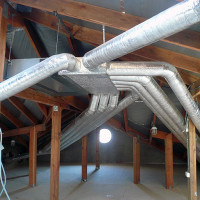 Cottage ventilation: options for organizing an air exchange system + device rules
Cottage ventilation: options for organizing an air exchange system + device rules 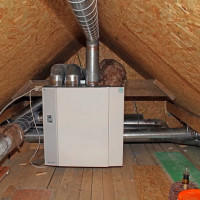 Ventilation in a two-story private house: options for organizing trouble-free air exchange
Ventilation in a two-story private house: options for organizing trouble-free air exchange 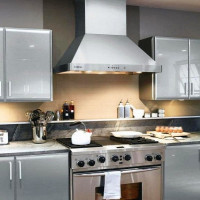 Ventilation in houses with gas stoves: rules and regulations in the organization of stable air exchange
Ventilation in houses with gas stoves: rules and regulations in the organization of stable air exchange 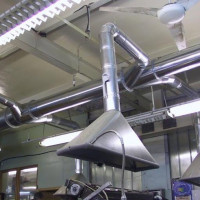 Ventilation of industrial premises: rules for the organization of air exchange
Ventilation of industrial premises: rules for the organization of air exchange  Frequency rate of air exchange in office premises: norms and rules for the organization of proper air exchange
Frequency rate of air exchange in office premises: norms and rules for the organization of proper air exchange 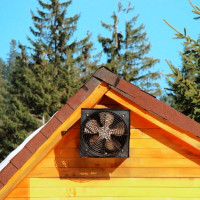 Ventilation in a wooden house: rules for providing a log house with an air exchange system
Ventilation in a wooden house: rules for providing a log house with an air exchange system  How much does it cost to connect gas to a private house: the price of organizing gas supply
How much does it cost to connect gas to a private house: the price of organizing gas supply  The best washing machines with dryer: model rating and customer tips
The best washing machines with dryer: model rating and customer tips  What is the color temperature of light and the nuances of choosing the temperature of the lamps to suit your needs
What is the color temperature of light and the nuances of choosing the temperature of the lamps to suit your needs  Replacement of a geyser in an apartment: replacement paperwork + basic norms and requirements
Replacement of a geyser in an apartment: replacement paperwork + basic norms and requirements